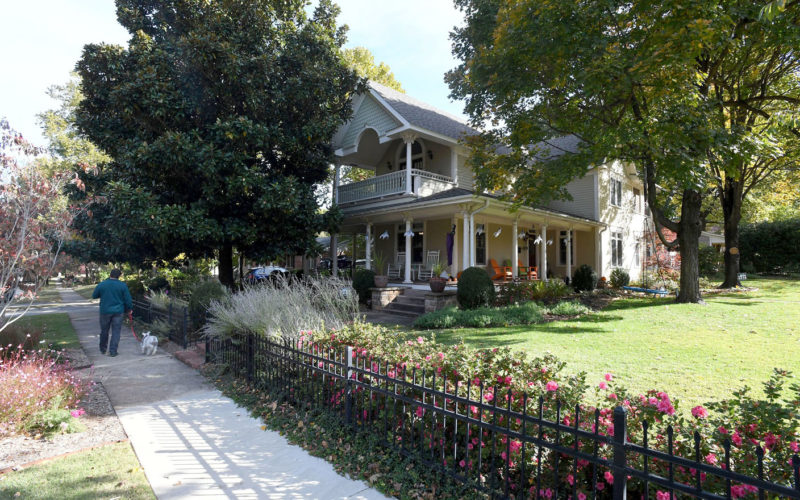Petition ready for historic district
STACY RYBURN
sryburn@nwadg.com
Residents of Fayetteville’s Washington-Willow Historic District will soon be asked to form the first preserved neighborhood in the city.
Members of the city’s Historic District Commission on Oct. 17 agreed to petition neighbors to establish a preservation district. Anyone who owns property within its boundary would have to get approval from the commission to demolish a building in the district.
The proposal also would include mandatory and advisory design guidelines for renovation of existing buildings or construction of new ones.
Commissioners hope to get neighbors to knock on as many doors as possible between now and the next commission meeting, said Katie Mihalevich, a commissioner who lives in the Washington-Willow neighborhood. The next scheduled meeting is Dec. 12.
Mihalevich said she plans to canvass the neighborhood and hopes to clarify any misconceptions about the regulations. For instance, people would still be able to paint their homes any color they want. Additionally, interior modifications aren’t included. The commission is primarily concerned with what can be seen outside from the right of way, she said.
“The whole motivation is we want to prevent demolition of structures that contribute to the heritage and the integrity of the neighborhood,” Mihalevich said. “We also want to have some controls in place so that new construction doesn’t stick out like a sore thumb. We want the construction to be homogeneous with the scale and the character and the materials of the neighborhood.”
The City Council in August last year authorized paying $20,000 to consultant Thomason and Associates, which put together the 119-page guideline book.
The Washington-Willow neighborhood, along with four others, is on the National Register of Historic Places. Being on the national register does not carry any regulatory power. However, the state allows cities to establish local preservation districts and regulate them.
The idea is to keep the initiative neighborhood-driven, said Andrew Garner, city planning director.
If a majority of the estimated 260 property owners are in favor, the petition will go to the City Council. The council will take public comment and decide whether to create the district, Garner said.
The council has the option to create the district without a petition if the boundary is the same as the one drawn for the national register, Garner said.
“I don’t think the city administration or council would want to do that against the residents’ wishes,” he said.
Carol Duerr, who owns a Dutch Colonial Revival-style house built in 1904 on East Dickson Street, said she participated in a survey a few months ago that helped shape the guidelines, but hasn’t had a chance to read them yet.
Duerr said she doesn’t like the idea of a panel of people telling property owners what to do with their homes. At the same time, the character of the neighborhood needs to be preserved, she said. The regulations should be broad, without causing a homeowner to have to go to the commission just to remove a nail, Duerr said.
“I guess I’m kind of in the middle,” she said. “I don’t want a lot of laws put on me, but then again we have to have something that says you cannot take down these old houses to put up some Jetson-style house. Otherwise, there goes the quaintness of our historic district.”
About 50 Fayetteville residents voiced interest in having the city come up with a historic preservation district during a community gathering at Ozark Natural Foods in February 2018.
The 150-year-old Stone-Hilton house at Lafayette Street and Willow Avenue came down in the summer of 2017. The move sparked an outcry among residents concerned the city’s historic structures had no regulatory protection. The home’s owners, Ben and Jane Meade, had multiple inspections done that determined the house needed to be demolished.
Under the proposal, anyone who wants to significantly alter or demolish a historic structure within the district would first have to get a certificate from the commission. One set of guidelines, classified as mandatory, would require a property owner to request permission to do certain types of work on a home. Those guidelines include demolition, new construction, windows and some types of vinyl siding.
Another set of guidelines, being called advisory, would be put on the commission’s consent agenda and likely approved without discussion. Those guidelines cover anything to do with chimneys, awnings, doors and entrances and other parts of a home.
One owner from each piece of property will be counted in the petition, Garner said.
If a property owner violates the regulations, he could be subject to the city’s standard penalty for violating city code, which is a fine of up to $500, City Attorney Kit Williams said. The property owner also could get a fine of up to $250 per day for a continuing violation.
That’s a long and tedious process, Williams said. Charges would have to be filed with the city prosecutor, and a municipal judge would decide the matter. Williams said he hopes if the council adopts a local preservation district, it will do so with a heavy majority of the neighbors on board.
“We’re talking about something that’s pretty intrusive on an owner’s right of their property,” he said. “It certainly should not be a really close question about whether most residents want it. Obviously, there might some people who are against it no matter what. That doesn’t mean the City Council can’t act.”
__
Regulations
The Historic District Commission in August agreed on a set of design standards for the Washington-Willow neighborhood. Each item has a set of regulations associated with it in the 119-page guideline book.
Mandatory guidelines
• Demolition
• New construction
• No abrasive cleaning of brick
• No vinyl siding unless it matches the existing wood profiles and does not conceal window and door trim and does not remove or cover architectural details
• Mechanical equipment may not be roof mounted as viewed from the street
• No enclosure of front porches for additional living space (screening in porches as unconditioned space is permitted)
• Retaining walls
• New windows
• Exterior Insulation Finishing Systems (EIFS) prohibited in all renovation and new construction
• No aluminum or vinyl columns for front porches
Advisory guidelines
• Exterior materials (except vinyl siding as noted under mandatory list above)
• Architectural features
• Awnings
• Chimneys
• Doors and entrances
• Foundations
• Gutters and downspouts
• Lighting
• Mechanical systems (except roof mounted visible from the street)
• Paint and colors
• Roofs
• Window repair and rehabilitation
• Fences, gates
• Garages and outbuildings
• Walkways
• Energy retrofits (addition of solar panels)
The Historic District Commission will not regulate paint or paint colors.
Source: Staff report






